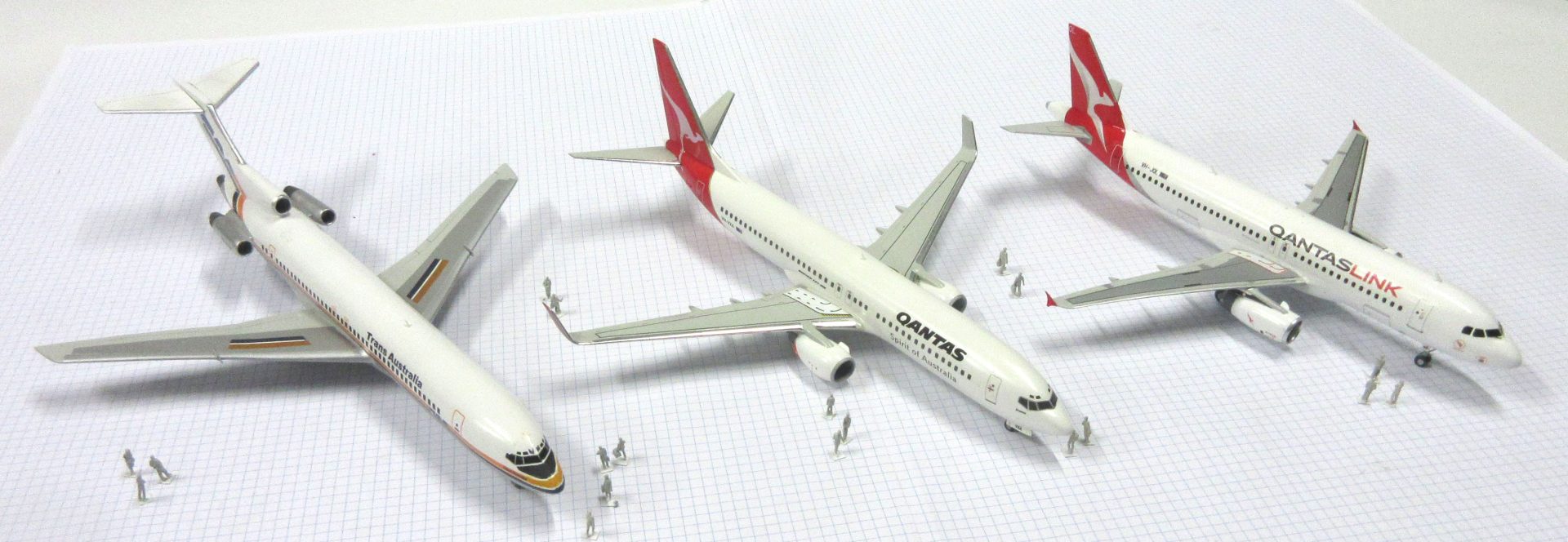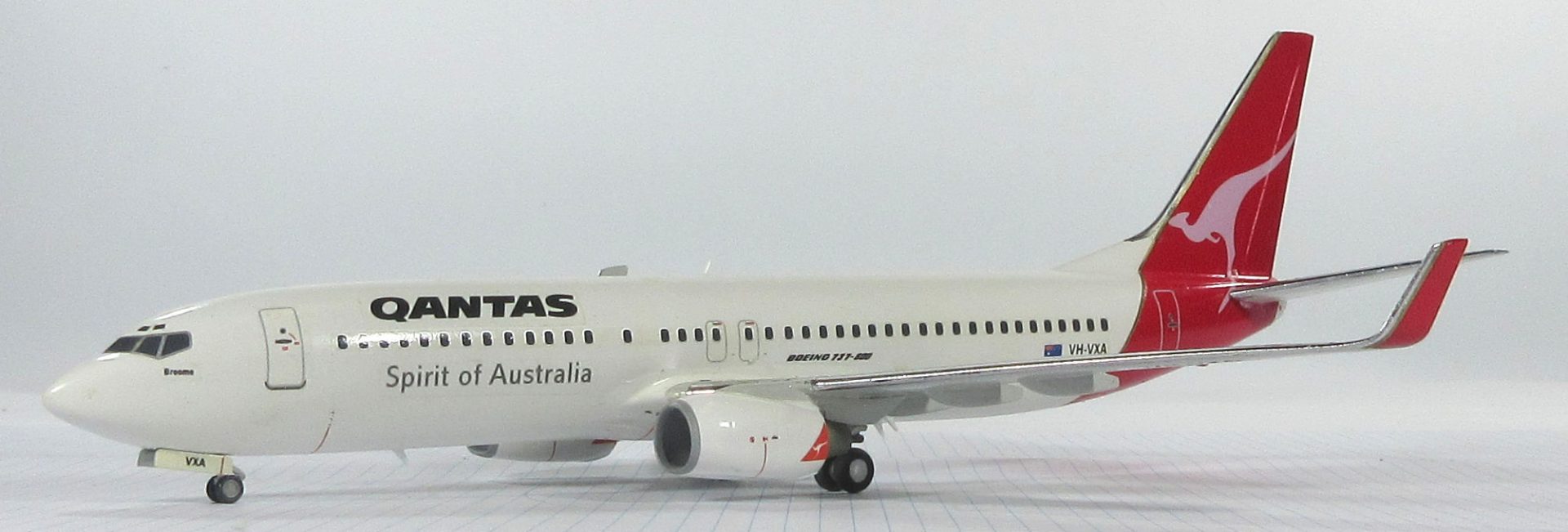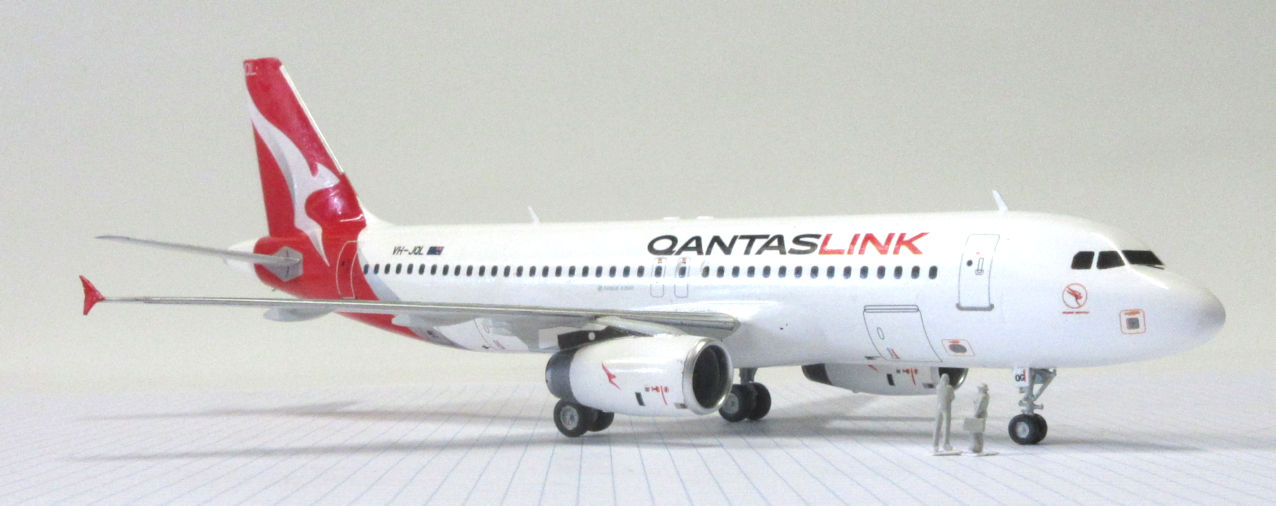Three Airliners in Six Decades
Boeing 727-200 – Boeing 737-800 – Airbus A.320

Everyone knows that I think airliners are way cool. I like them because, with very rare exceptions, they have never deliberately killed anyone or destroyed anything. Their business is to carry people and freight from place to place as safely as possible. In other words, their task is to make people happy, not unhappy as military aircraft are designed to do. To those who don’t care to look, they all appear more or less the same and most of them are painted white these days. But if you care to look deeper you will find that airliners have their own histories and stories to tell. Here are three that span six decades of air transport history.
Boeing 727-200 in 1/144 by Airfix
The first Boeing 727 flew in 1963 and Australia’s two domestic airlines, Ansett-ANA and TAA, started services with Boeing 727-100s in November 1964. Their much higher speeds and passenger capacities helped popularize domestic air travel so, in 1973, the airlines began using larger Boeing 727-200s which could carry over 150 passengers. The aircraft this model represents, VH-TBM, started service with TAA in 1976. In 1981 TAA adopted a new livery and this aircraft was repainted in that livery the same year. (This is the livery represented on this model.) In 1986 TAA was rebranded as Australian Airlines and this airliner was then repainted in the new livery. Qantas took over TAA in September 1992 and many ex-TAA aircraft were repainted in Qantas livery. VH-TBM was not one of them and it flew its last revenue flight in Australia in December 1992 still in Australian Airlines livery. It had flown almost 45,000 hours and completed 34,600 take-off and landings. It was later sold to a company in Mexico and flew for Aviacsa from 1997 to 2007 when it flew the last Boeing 727 service in Mexico. It was last noted in a derelict state at Mexico City in 2014.
This model was made using the old Airfix kit that was first published as the shorter 727-100 in 1966 and republished as a Boeing 727-200 with the longer fuselage in 1983. It was republished again in the 2010s with new decals. Being in this tiny scale there’s not much call for lots of detail and this kit doesn’t give you any. I liked it because there were lots of them around cheaply so I could make a fleet of them without too much expense. Often the aftermarket decals sets I used cost more than the second hand kits. In 2016 Revell republished their 1964 Boeing 727 but it is the shorter -100 version. Minicraft published a 727-200 kit in 2004 which has since appeared in a number of boxings. The review of the Minicraft kit in Fine Scale Modeler points out its good and bad points. The build review of the Airfix kit on JN Model Kit Reviews concludes that this is a kit you can ‘live with’. That really applies to all the 727 kits currently available.
Boeing 737-800 in 1/144 by Revell
At the same time that Boeing 767s became weapons of war in September 2001 one of Australia’s two major airlines, Ansett, went broke and stopped flying. This left as huge capacity gap in Australian air transport which had to be filled quickly. Happily for Qantas, its desperate need for additional capacity came at the same time as a dramatic collapse in passenger demand in the United States which left airlines there with airliners they had ordered but no longer needed or wanted. Because of these two factors Qantas was able to buy a lot of new Boeing airliners cheaply and quickly. One of them was this Boeing 737-800 (VH-VXA) which had been ordered originally by American Airlines. Qantas took over the order in October 2001, it rolled off the production line in December and started flying revenue services in Australia in February 2002. It was Qantas’s first Boeing 737-800 and is still in service with that airline.
This model was made using the Revell 1/144 kit which was first published in 1999 and is still a very nice little kit to work with. This kit also appears in a Hasegawa box. The detailing is as good as is needed, I think, for a 1/144 scale kit and the parts fit is excellent. My only suggestion would be to buy one of the early boxings if you can because there is sometimes more flash that you’d like on later boxings. The review in Modeling Madness doesn’t agree with me, ‘takes work getting a properly finished product’, it says. The better bet is probably the Zvezda kit which was published in 2017. The long build review in Hyperscale put it succinctly, ‘Breathtaking’.
Airbus A.320 in 1/144 by Zvezda
The Airbus A.320 is made by a consortium of European companies set up to compete with United States aircraft manufacturers. The first one made its maiden flight in February 1987 and 10,340 had been manufactured by the end of April 2023. The aircraft this model represents (VH-JQL) first flew in May 2004 and was flown out to Australia by stages, arriving in July. It was owned by a leasing company and leased to JetStar Airways, a low-cost subsidiary of Qantas. In addition to its major airline and its JetStar subsidiary, Qantas also controls a number of smaller companies which feed into its main services. It began gathering them together under the QantasLink brand in the aftermath of the Ansett collapse. One area of great growth is internal air services in Western Australia associated with mining and, to meet this, QantasLink began using A.320s for the first time. The lease of this aircraft was transferred from JetStar to Network Aviation and it was repainted in QantasLink livery in November 2019. It is currently in service with that airline.
This model was made using the Zvezda 1/144. I’ve also made A.320 models using the older Revell kit which was first published in 1988. They were both good kits with the Zvezda one being a little better. However it suffers from slats sand flaps that can be positioned up or down for landing and take off which causes problems when it comes to making the model with the flaps and slats up. There are a couple of problems with the Revell kit. One is that the moulds are getting old and there is flash on the later boxings. The other problem is that the A.320 comes with two engine options but the Revell kit only has one or the other, so you have to be careful about the kit you buy to get the right engines for the model you are going to make. The review of the Revell kit in Modelling Madness is not as great fan of it but the build review in Britmodeller shows what can be done with it. An in-box review of the Zvezda kit on Modeling Madness says that the Zvezda kit is as timely replacement for the old Revell kit and the review of the Zvezda kit in Fine Scale Modeler has only good things to say about it. I have several of the Zvezda kits waiting to be made (one of these days) and none of the Revell kits, which tells you which way I am now leaning.



